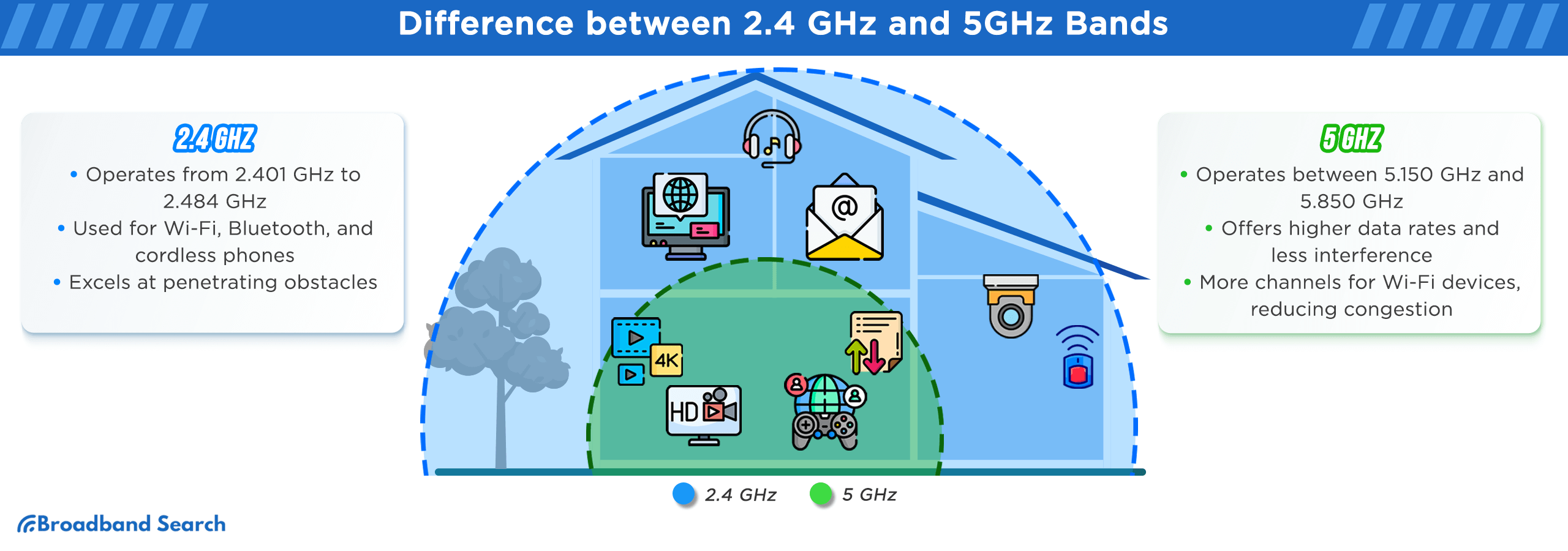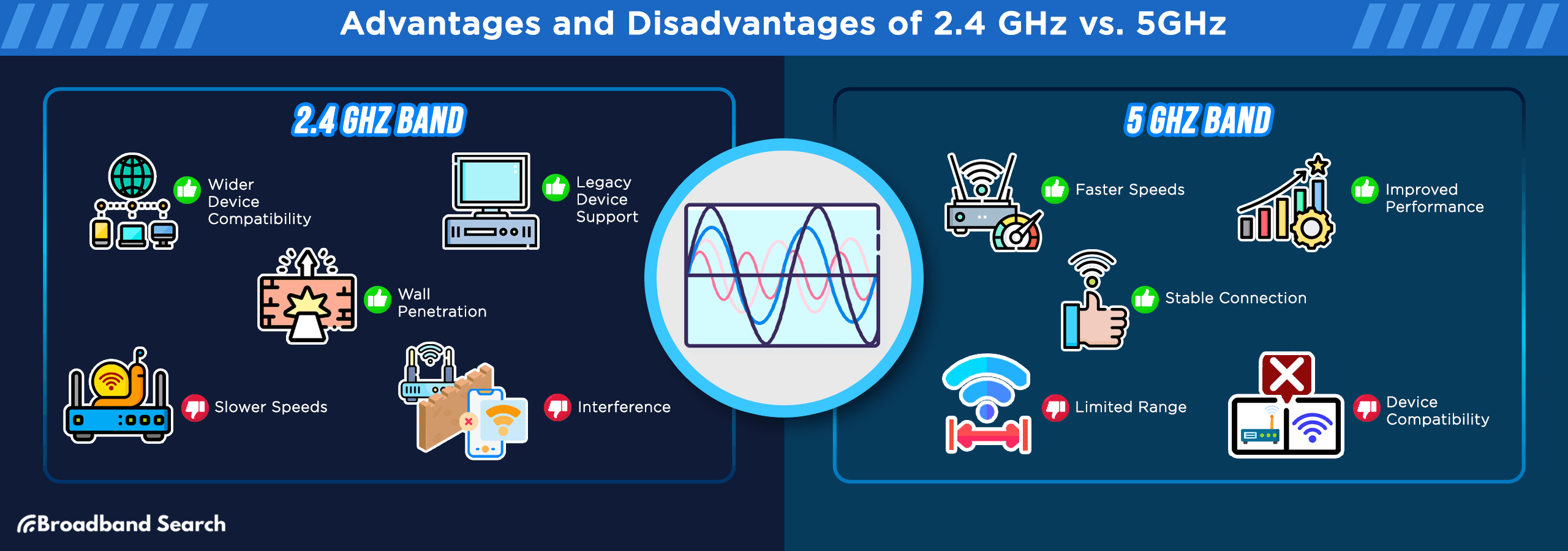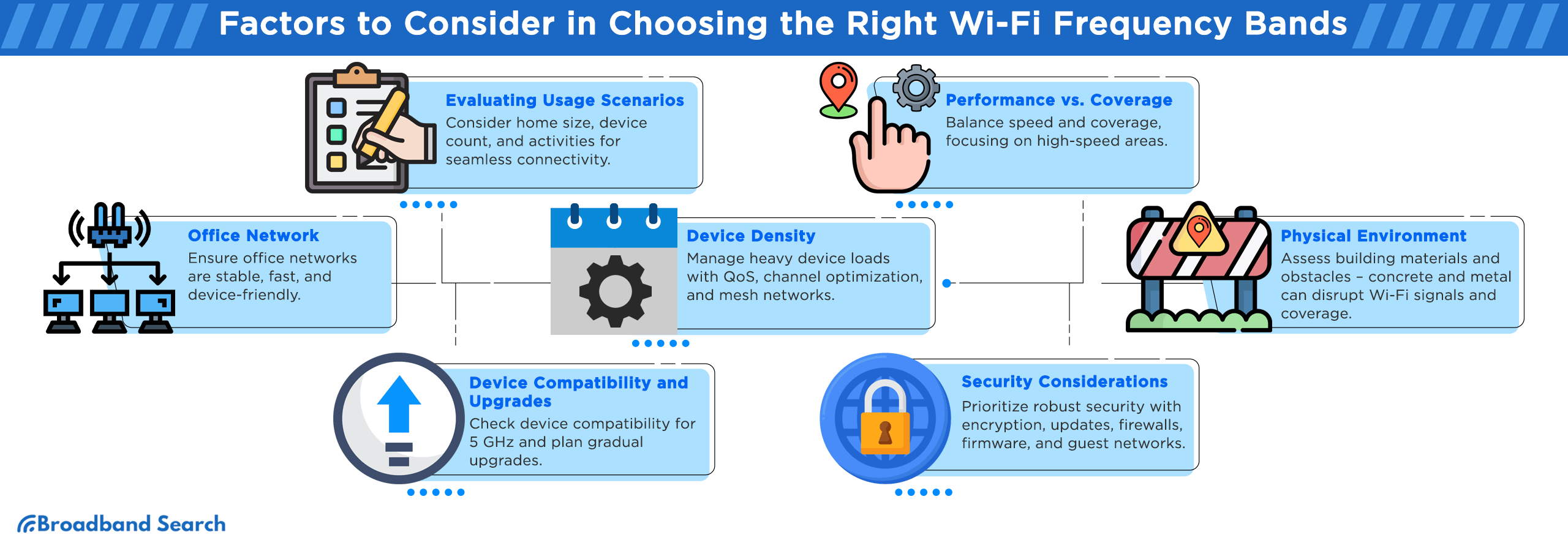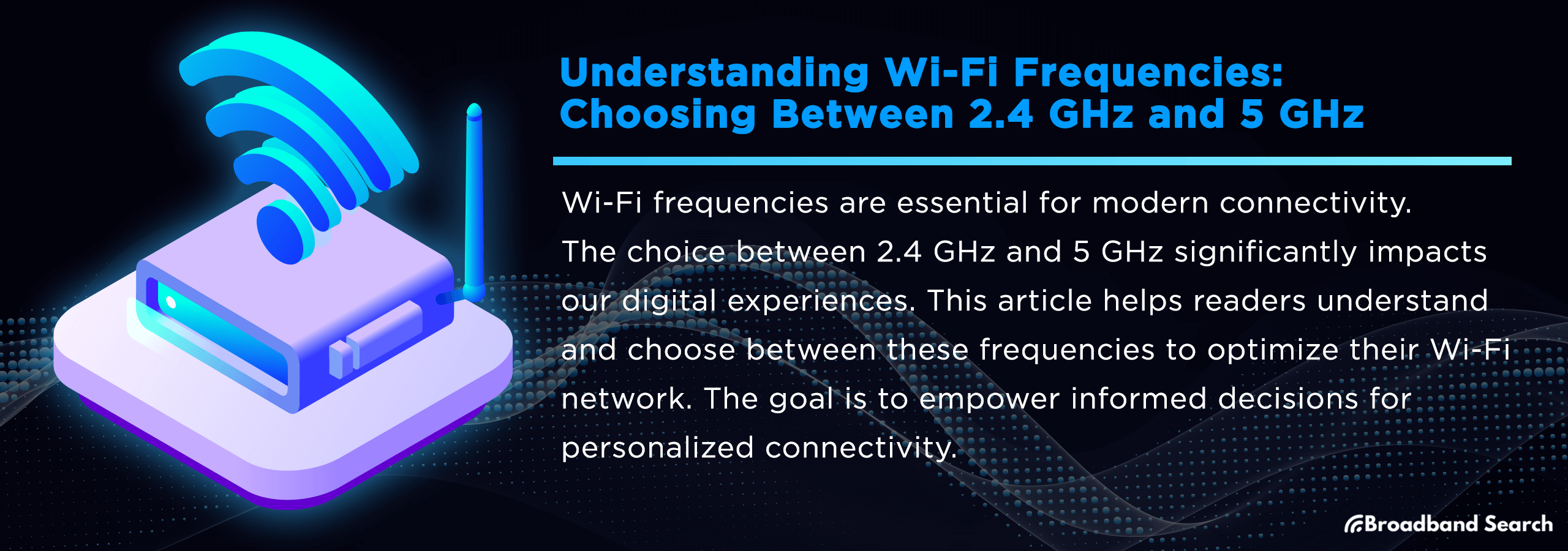In the realm of wireless communication, Wi-Fi frequencies are the bedrock upon which our modern connectivity depends. The choices we make regarding these frequencies have a profound impact on our daily digital experiences. One pivotal decision is choosing between the widely used 2.4 GHz and the newer 5 GHz frequency bands.
This article is your gateway to understanding the core of wireless communication—Wi-Fi frequencies—specifically focusing on the choice between 2.4 GHz and 5 GHz. Our mission is to impart knowledge that empowers you, the reader, to make well-informed decisions regarding these frequencies. By the end of this exploration, you'll have the insights needed to optimize your Wi-Fi network for your unique needs and preferences.
Understanding Wi-Fi Frequencies

In-depth Explanation of Radio Frequencies in Wi-Fi
2.4 GHz Band:
- Frequency Range and Applications: The 2.4 GHz band operates in the range of 2.401 GHz to 2.484 GHz. It has been traditionally used for various wireless applications, including Wi-Fi, Bluetooth, and some cordless phones. Due to its lower frequency, it's capable of better penetrating obstacles like walls.
- Historical Context and Common Usage Scenarios: This band gained early popularity for Wi-Fi due to its availability and compatibility with older devices. It's commonly used in residential settings and small offices where device compatibility is essential.
5 GHz Band:
- Frequency Range and Its Advantages: The 5 GHz band operates in a higher frequency range, typically between 5.150 GHz and 5.850 GHz. It offers distinct advantages over the 2.4 GHz band, such as higher data transfer rates and reduced interference. This band provides more available channels for Wi-Fi devices to operate on, reducing congestion and improving overall network performance.
- Emerging Importance in Modern Wi-Fi Networks: The 5 GHz band is becoming increasingly vital in modern Wi-Fi networks as more devices support it. It offers improved speed and reliability, making it ideal for high-demand applications and densely populated areas.
Comprehensive Exploration of Key Differences Between 2.4 GHz and 5 GHz Frequencies
Speed and Throughput Capabilities
Data Transfer Rates in Both Bands: The 2.4 GHz band typically offers lower maximum data rates, often ranging from 150 Mbps to 600 Mbps, depending on the specific Wi-Fi standard used (e.g., 802.11n). In contrast, the 5 GHz band provides significantly higher data rates, with potential speeds reaching 1 Gbps or more, especially with 802.11ac and 802.11ax (Wi-Fi 6) standards.
In practice, this means that tasks like downloading large files or streaming high-definition videos will perform noticeably better on the 5 GHz band, resulting in reduced buffering and faster load times compared to the 2.4 GHz band.
Range and Coverage Characteristics
Understanding Signal Reach and Its Implications: The 2.4 GHz band offers better range and wall penetration capabilities, making it suitable for larger coverage areas and spaces with physical obstructions. Signals in the 5 GHz band are generally less effective at penetrating walls and have a shorter effective range.
Practical Applications in Various Environments: In scenarios where coverage over long distances or through multiple walls is crucial, the 2.4 GHz band is preferred. However, the 5 GHz band is ideal for situations where high-speed connections are required over shorter distances with minimal obstructions.
Interference and Congestion Challenges
Identifying Sources of Interference in Both Bands: In the 2.4 GHz band, common sources of interference include microwave ovens, cordless phones, and neighboring Wi-Fi networks operating on the same channel. In the 5 GHz bands, interference is often less common but can still occur from other Wi-Fi networks and certain electronic devices.
Proactive Strategies to Mitigate Interference: To reduce interference in the 2.4 GHz band, consider changing Wi-Fi channels and using dual-band routers that can switch between 2.4 GHz and 5 GHz. In the 5 GHz band, take advantage of the wider range of available channels and the fact that fewer devices typically operate in this band to minimize interference and congestion. Additionally, using 5 GHz-capable devices can help maximize performance in this band.
Advantages and Disadvantages of 2.4 GHz vs. 5 GHz

Advantages of 2.4 GHz and 5 GHz Bands
Advantages of 2.4 GHz Band - Wider Device Compatibility and Seamless Connectivity:
- Seamless Connectivity: The 2.4 GHz band is renowned for its extensive compatibility, making it an ideal choice for older and newer devices alike. It works seamlessly with a wide range of hardware, including smartphones, laptops, gaming consoles, and Internet of Things (IoT) devices. This compatibility ensures that both legacy devices and the latest gadgets can connect effortlessly to a 2.4 GHz Wi-Fi network.
- Strategies for Legacy Devices: For legacy devices, the 2.4 GHz band is a lifesaver, as older hardware often lacks support for the 5 GHz band. When setting up a Wi-Fi network, consider reserving the 2.4 GHz band specifically for these devices to ensure their continued functionality. IoT devices, which may operate on the 2.4 GHz band, also benefit from the band's widespread compatibility.
- Wall Penetration: 2.4 GHz waves excel at penetrating walls and other obstacles, making them highly suitable for environments with numerous physical barriers. This characteristic is particularly beneficial in homes and buildings constructed with dense materials, ensuring that Wi-Fi signals can reach every nook and cranny.
Advantages of 5 GHz Band - Faster Speeds and Reduced Interference:
- High-Speed Applications: The 5 GHz band offers significantly faster data transfer rates compared to the 2.4 GHz band. This makes it perfect for data-intensive activities like streaming 4K videos, online gaming, and large file downloads. Users can experience smoother, lag-free performance, especially in scenarios that demand high-speed connections. In the 5 GHz band, the potential for high-speed applications is unleashed. Tasks that require rapid data transmission, such as video editing, video conferencing, and online backups, benefit immensely from the higher speeds available in this band. It elevates the overall user experience to a new level of efficiency and productivity.
- Improved Performance: To illustrate the advantages of the 5 GHz band, consider real-world scenarios. For instance, streaming a 4K movie without buffering, enjoying low-latency gaming, or swiftly transferring large files between devices all exemplify the improved performance made possible by the 5 GHz bands.
- Stable Connection: The 5 GHz band experiences fewer interference issues compared to the crowded 2.4 GHz band. This translates into a more stable and reliable connection. Users can count on their Wi-Fi networks to deliver consistent performance, especially in environments with multiple Wi-Fi networks and electronic devices. The reduced interference in the 5 GHz band not only enhances the user experience but also ensures network reliability. Tasks like video conferencing, online gaming, and streaming become smoother and more dependable, reducing frustration and improving productivity. This reliability is especially vital in modern homes and workplaces
Disadvantages of 2.4 GHz and 5 GHz Bands
Disadvantages of 2.4 GHz Band - Slower Speeds and Increased Susceptibility to Interference:
- Slower Speeds: The 2.4 GHz band generally offers slower data transfer rates compared to the 5 GHz band, which can be noticeable in tasks requiring high-speed connections.
- Interference Challenges: Common interference sources in the 2.4 GHz band, such as microwave ovens and neighboring Wi-Fi networks, can lead to performance issues.
- Mitigating Interference: Implementing strategies like channel selection and device positioning can help alleviate interference-related problems.
Disadvantages of 5 GHz Band - Limited Range and Device Compatibility Considerations:
- Limited Range: The 5 GHz band has a shorter effective range compared to the 2.4 GHz band, which can pose challenges in larger spaces or environments with multiple obstacles.
- Signal Strength: Instances where signal strength becomes an issue include large homes with distant rooms or offices with thick walls.
- Device Compatibility: Ensuring that devices support the 5 GHz band is crucial, as not all hardware is compatible.
- Strategies for Compatibility: Strategies to address device limitations in the 5 GHz band may involve upgrading devices or configuring dual-band routers.
Factors to Consider When Choosing

Before delving into the specifics of Wi-Fi frequency bands, it's crucial to grasp the factors that influence your choice. The ideal frequency band depends on various considerations, including your usage scenarios, the number of devices on your network, the physical environment, device compatibility, and security concerns.
Instructive Guidance on Evaluating Usage Scenarios
Home Network Considerations Demystified
Tailoring Wi-Fi Frequency for Residential Bliss: Choosing the right Wi-Fi frequency for your home network involves understanding the specific requirements of your household. Consider factors such as the size of your home, the number of devices used, and your typical online activities to create a tailored network that ensures seamless connectivity.
Achieving a Harmonious Balance Between Performance and Coverage: In a residential setting, striking the right balance between Wi-Fi performance and coverage is essential. Determine the areas where you need the highest speeds, like the living room for streaming, and ensure that the Wi-Fi signal reaches even the farthest corners of your home, such as the basement or backyard.
Office Network Requirements Decoded
Meeting the Unique Demands of Business Environments: Office networks have distinct demands, such as supporting a multitude of devices, handling video conferencing, and ensuring network stability for critical tasks. Tailor your Wi-Fi frequency choice to meet these demands, emphasizing both speed and reliability to support productivity.
Prioritizing Stability and Speed in Professional Settings: In a professional setting, network stability is paramount. The 5 GHz band can provide the necessary speed for data-intensive tasks, while careful network configuration and placement of access points can ensure stable connections throughout the office.
Device Density's Impact on Network Performance
Strategies for Accommodating a Multitude of Devices on One Network: High device density can strain a Wi-Fi network. Implement strategies such as Quality of Service (QoS) settings, optimizing channel usage, and considering advanced access point solutions like mesh networks to maintain network stability even under heavy device loads.
Maintaining Network Stability Even Under Heavy Device Loads: In environments where numerous devices are connected simultaneously, maintaining network stability is vital. Load balancing, frequency optimization, and regular network monitoring are crucial for ensuring uninterrupted connectivity.
Unraveling the Physical Environment Puzzle
- Evaluating Building Materials and Their Role in Signal Propagation: The materials used in your building significantly impact Wi-Fi signal propagation. Materials like concrete and metal can block or reflect Wi-Fi signals, affecting coverage. Understanding your building's construction materials helps you make informed frequency choices.
- Identifying and Conquering Obstacles to Signal Reach: Identifying signal-blocking obstacles, such as thick walls or large appliances, allows you to strategically position your router or consider signal boosters to overcome these challenges.
- Practical Optimization Techniques for Signal Propagation: Techniques like router placement, proper antenna orientation, and signal boosting can optimize signal propagation within your specific environment.
Device Compatibility and Upgrades
Assessing Existing Devices for 5 GHz Compatibility: Before transitioning to the 5 GHz band, evaluate your existing devices for compatibility. Not all devices support this band. Identify those that do and are capable of harnessing the benefits of faster speeds and reduced interference.
Seamless Strategies for Upgrading Devices to Unlock 5 GHz Capabilities: If some of your devices are not 5 GHz-compatible, consider upgrading or replacing them strategically over time. This gradual approach ensures a seamless transition to the 5 GHz band while optimizing your network's performance.
Security Considerations
When considering your Wi-Fi frequency choice, it's vital to delve into the security implications associated with it. Regardless of whether you opt for the 2.4 GHz or 5 GHz band, understanding the importance of network security remains paramount. To bolster your Wi-Fi ecosystem's security, it's advisable to prioritize robust measures. This includes selecting strong encryption methods, ensuring regular password updates, and implementing firewalls to fortify your network's defenses against potential threats.
In the pursuit of a secure Wi-Fi network, readers are encouraged to proactively take steps to safeguard their digital domains. Stress the significance of continually updating devices and firmware to patch vulnerabilities. Consider enabling WPA3 encryption for advanced security. Furthermore, setting up guest networks can effectively isolate traffic and protect sensitive data from prying eyes. These measures are essential for ensuring the safety and integrity of your network, irrespective of the chosen frequency.
Making the Right Choice
Guided Decision-Making Journey
- Analysis of Specific Needs and Requirements: Begin the decision-making process by conducting a comprehensive analysis of your unique needs and requirements. Consider factors such as the size of your space, the number of devices, and the nature of tasks performed on the network. This step-by-step assessment ensures a tailored Wi-Fi solution that aligns with your specific demands.
- Select the Ideal Frequency Band: After a meticulous analysis of your needs, readers are empowered to confidently select the ideal frequency band. Whether it's the 2.4 GHz band for broader coverage or the 5 GHz band for faster speeds, this decision is based on a thorough understanding of what best suits their unique circumstances and preferences.
- Hands-On Configuration Tips for Routers to Maximize Performance: Once you've made your frequency choice, it's essential to configure your Wi-Fi router optimally. Implement hands-on tips and best practices to ensure peak performance. This may involve selecting the right channel, updating firmware, and optimizing router placement within your space. These practical steps will help you maximize the potential of your chosen frequency band and enjoy an efficient, stable Wi-Fi network.
Tips for Optimizing Wi-Fi Performance
Steps for Fine-Tuning Wi-Fi Networks
1. Router Placement:
- Identifying Optimal Router Locations: Carefully choose the placement of your Wi-Fi router. It should be positioned centrally within your home or workspace, minimizing the distance to most devices and reducing signal obstructions.
- Maximizing Signal Reach with Strategic Placement: Elevate your router for improved signal propagation. Placing it on a high shelf or wall mounting can minimize signal blockage from furniture and walls.
2. Channel Selection and Optimization Techniques Demystified:
- Mastering Channel Interference and Selection Strategies: Overcome channel interference by analyzing neighboring Wi-Fi networks. Choose a less crowded Wi-Fi channel to reduce interference and improve network stability.
- Tackling Channel Congestion for Rock-Solid Connections: Routinely monitor channel congestion and make adjustments as needed. Tools like Wi-Fi analyzers can help identify the least congested channels, ensuring rock-solid connections for your devices.
3. Firmware Updates - Significance of Up-to-Date Router Firmware:
Regularly update your router's firmware to benefit from improved performance, enhanced security, and bug fixes. Many router manufacturers release firmware updates to address known issues and optimize router functionality.
4. Expanding Coverage with Wi-Fi Extenders or Mesh Networks:
In larger spaces where a single router may struggle to provide comprehensive coverage, consider Wi-Fi extenders or mesh networks. These devices can seamlessly expand your network's reach, ensuring consistent connectivity throughout your space. Evaluate which solution best suits your needs and budget for efficient Wi-Fi coverage.
The Bottom Line
As we've navigated the intricate landscape of Wi-Fi frequency selection, we’ve shed light on the core differences between the 2.4 GHz and 5 GHz bands. Key takeaways include understanding the advantages and disadvantages of each band, considering factors such as device compatibility, network requirements, and the physical environment, and optimizing your network for peak performance.
The importance of informed decision-making when choosing a Wi-Fi frequency cannot be overstated. It directly impacts the quality of your wireless experience, from the speed of your internet connection to the stability of your network. We encourage you to implement the strategies and tips discussed in this article. Tailor your Wi-Fi setup to your specific needs and environment, optimizing router placement, channel selection, firmware updates, and even considering Wi-Fi extenders or mesh networks where necessary. By doing so, you'll not only enjoy optimal Wi-Fi performance but also a seamless and reliable wireless connection that enhances your daily digital life.
FAQ
Is it possible to switch between 2.4 GHz and 5 GHz on the same router?
Yes, many modern routers support both frequency bands and offer dual-band functionality. You can typically configure your router to broadcast both bands simultaneously or choose one over the other based on your needs.
What can I do to ensure device compatibility with my chosen frequency band?
Check your device specifications to confirm if they support the selected frequency. If not, consider upgrading devices or using external adapters to enable compatibility with the chosen band.
How can I secure my Wi-Fi network, regardless of the frequency chosen?
Implement robust security measures such as strong passwords, encryption (like WPA3), firmware updates, and guest networks to protect your Wi-Fi ecosystem from potential threats and unauthorized access.
Can I use both 2.4 GHz and 5 GHz bands simultaneously in my home or office network?
Yes, you can use both bands simultaneously if your router supports dual-band functionality. This can provide flexibility for connecting various devices with different frequency requirements.
What are some common sources of interference in Wi-Fi networks, and how can I mitigate them?
Common sources of interference include neighboring Wi-Fi networks, microwave ovens, cordless phones, and electronic devices. You can mitigate interference by selecting less crowded Wi-Fi channels, optimizing router placement, and using interference-resistant Wi-Fi technologies like MU-MIMO.

